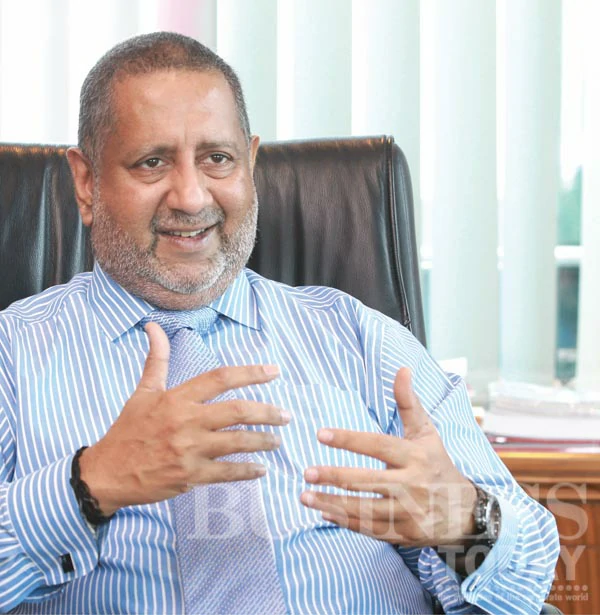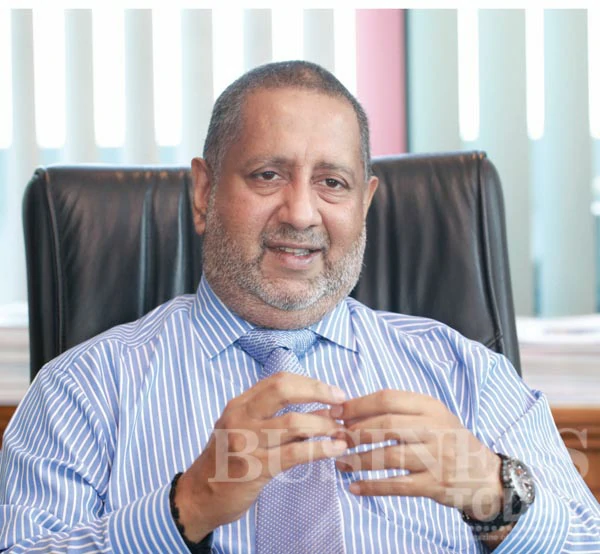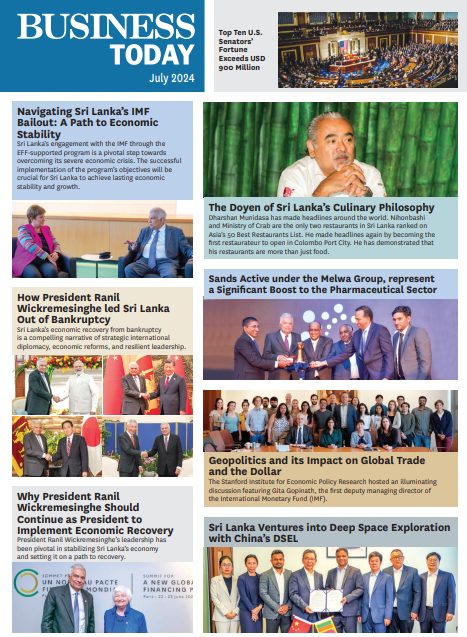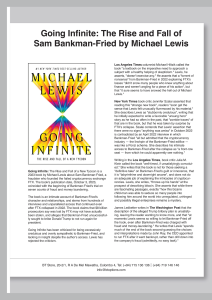
Rajendra Theagarajah has been in the banking sector for 29 years where his global exposure proved to be an advantage in his banking career in Sri Lanka. After heading one of Sri Lanka’s leading banks, Hatton National Bank (HNB) for nine years, Rajendra Theagarajah is stepping forth into the next stage of his career. He urges Sri Lankan professionals domiciled abroad to realise the importance of creating a better future for the next generations by contributing to the development of the country during this post war era.
By Udeshi Amarasinghe
Photography Mahesh Bandara and Damith Wickramasinghe
You have been in the banking industry for 29 years, what can you tell us about your experiences?
I am a very simple person who got into banking by accident. I actually trained as a chartered accountant and moved very early into a career in banking lured by the prospect of foreign travel. I focused more on the business side than the numbers. During the first ten years I was in Europe and I worked with one of the largest US money centre banks in the world – Chase Manhattan, which is now JP Morgan. This gave me a global exposure.
My job at Chase Manhattan entailed extensive travel from Europe to Middle East to North Africa, which gave me insight to the cultural diversity of these markets. It was a tremendous experience as no two markets were alike and this proved to be very helpful after coming back to Sri Lanka. Chase Manhattan invested heavily on staff training and orientation and that is very important. At Chase Manhattan the box was drawn for you and you knew exactly what had to be done. But in markets such as Sri Lanka the difference is that in local banks you have to draw the box yourself, therefore the training that you receive abroad helps in numerous ways when you return to the country.
How has the industry changed over the years?
When looking at Sri Lanka, we need to consider the two eras; pre 2009 and post 2009. During the 1990s and 2000s, I would consider the Sri Lankan banking industry to have been on a defensive mode pre 2009 because you were afraid due to insecurity and the aim was to minimise risk and manage growth during extreme times of adversity. We are now in post conflict banking, there is more optimism and an unparalleled opportunity to go and be an active partner of growth. The approach and opportunities are quite different now for the right reasons.
We have seen policies changing almost every year in relation to the banking industry, how does this affect the industry as a whole as well as the customer?
From a policy framework point of view, the reduction of the financial services VAT and the income tax was a much needed and anticipated reform which was necessary to bring Sri Lanka to a comparable line with the rest of Asia. Then the expectation was that as a result, there would be a positive kickback or contribution to the bottom line, where banks were to deploy part of their savings for the long term development of the country.
For Larger Banks Like Ours Who Have A Long Term Commitment To The Country It’s A Very Timely Suggestion And A Fair Request And We Have Embraced It. It Wouldn’t Have Been Right If This Change In Policy Had Come Before The End Of The War. The Time Is Right Now And It Is Time For Development.
My personal opinion is that this was a very fair request and the bank that I represented (Hatton National Bank) had no problem in deploying this. For larger banks like ours, which have a long term commitment to the country, it’s a very timely suggestion and a fair request and we have embraced it. It wouldn’t have been right if this change in policy had come before the end of the war. The time is right now and it is time for development.
Are banks assisting entrepreneurs, new businesses, SMEs? It seems that it is the same businesses that are acquiring funding. Your thoughts?
In a way I would say it is a chicken and egg situation. It is the comfort factor for the bank like anybody else when they know the customer – very often the same entrepreneur who does one thing and does it well. When he comes back to secure further funding, the bank will oblige. Another aspect is the availability of information, transparency and how a customer packages himself to a bank.
Many customers become more transparent as the relationship grows and are able to give more information to the bank. They get better auditors and quality financial reporting. As such when they do that repeatedly well, naturally, the bank tends to back that group of investors because it is a partnership. But saying that, I would also say that the entire industry has recognised that small and medium scale entrepreneurs are very important in Sri Lanka’s development and we cannot ignore them.
The question is how deeply one will engage with SMEs. From our side there is an appetite, but even from the side of the SME there has to be an understanding. There has to be a better understanding of better corporatisation, better disclosure and willingness to be transparent instead of being defensive. Banks are funding using public depositors money, as such there is an expectation that when a bank is financing a business, they have thoroughly checked what they are lending for.
Even at a time where there is a slow growth in the economy of Sri Lanka, we still find banks doing well or say becoming richer. What are your thoughts on this?
We need to be mindful when we use the term ‘rich’, because we are talking with very relative numbers. Very often people do not realise the amount of assets that banks have to accumulate to get these numbers. If you look at the typical return the bank gets on its asset base, it is about 1.5 to 2 percent. To earn a billion rupees of profit after tax, the bank needs close to a 50 – 60 billion rupees worth of assets. But with any other business, the return would maybe ten times of that. People very often look only at the bottom line and come to the conclusion that the profits are large. But they don’t realise the amount of effort and capital that is required to generate that.
Then, when you say times of slowness, it is again relative. It is slow, but you are talking about a cycle. Most of us are not in this position for one year. We take a five to seven year view and in that cycle you expect to see two to three years of dip ups and downs. When you take a medium term view, you don’t suddenly stop and start in that journey. You build up a series of assets, mobilise financing and you support industries, where you will see benefits today of what you started three years ago. We may see a temporary slow down in the business, but what you have accumulated stays intact.
Sri Lankan banks seem to be risk averse, why is that? As an emerging economy we need banks to be more dynamic. Your thoughts?
I tend to differ slightly. Sri Lankan banks are not averse to risk, but they are mindful of the risks that they take and they have to be. In Sri Lanka, like in most other countries, the bulk of bank finances comes from customer deposits. There is an element of trust, where a customer or depositor places on the bank to take care of the money. The bank is accountable for that money. Then, the shareholders expect a fair return and they also expect banks to be mindful of the types of risk they take as well as identifying the risks accurately and taking the necessary safeguards.
I Would Say It Is Unfair To Say That Banks Have Not Taken Risks. It Is Still The Most Identified Component Within The Financial Eco System, Which Is Propelling And Financing Economic Growth.
As an example when it comes to HNB, I would never say we are risk averse. I would say we are risk conscious. We identify risks, manage the risk, price it accordingly and get in to the business. It’s very important that we engage the bank boards and the shareholders as well as the staff. The appetite for business will differ from bank to bank as well as their size.
The banking sector has close to five trillion rupees worth of assets that has not come overnight. I would say that the banking industry is the single most important element in the financial eco system, which is supporting growth. When you have that amount of dominance, I would say it is unfair to say that banks have not taken risks. It is still the most identified component within the financial eco system, which is propelling and financing economic growth. It is just that the level of growth after the war is at a different level, to maybe, what it was five years ago. The thirst for more capital and money has increased.
What is the future of banking in Sri Lanka?
This is my personal take and not of the bank I work for. The current economic growth has to continue, there is no question about it, and along with this growth the aspiration for a USD 4,000 per capita income will come true at some point. It may take one or two years, but having achieved USD 3,000 in 2012, it will happen. Then, income levels increase as well. With income levels going up, people’s lifestyles will change and with that change, people will have less time to come to a bank branch. Therefore, lifestyle banking and the use of electronic communication, which will challenge the traditional model will become a reality.
Banking services may be deployed lesser through the branch, but at a place where you would like to spend time such as in shopping malls or lifestyle stores. This is more of a reality now than in the past. As explained in the Road Map of the Central Bank, there are many incentives for direct access to markets and direct external borrowings, which means that the bigger businesses – in my opinion – will have lesser need to go through the traditional banks for funding, because they will have better direct access to tap the markets, locally and internationally. There will be a slight shift where the smarter banks will have to tap the next generation of emerging businesses – that is the SMEs. Therefore, SMEs will be very important.
As the bigger ones go directly to the market, allowing that share of the business to go out of the system will also be futile. So there is opportunity for the banks or the banks that have financial conglomeration with them to capture that part of the business through other offerings. For example, if you have an investment banking or corporate finance advisory shop, when someone goes to the capital market, we’re part of that process, not necessarily to lend, but to advise and capture. Similarly you will see as income levels grow there will be an attack on the lower cost savings base because the person today who puts the majority of the money to banks will have more sophistication and more demand to have a bit of their savings in the stock market or property or unit trust or whatever it is.
There will be an emerging opportunity for wealth management. The smarter banks who will recognise that will be part of these deposits, which will be eaten and can capture it in the system through other offerings. If something goes out of the bank say for unit trust, you could have your own unit trust to capture that. That would be the smart way to handle this. The future of banking will not be purely on a stand alone close loop basis. Banks will have to learn to collaborate with other entities in the system, say for example telecom operators and supermarkets, because while your good at churning out products and credit, cost effective distribution and communication will become key. Those are very important elements. The smarter way would be to collaborate and make the eco-system larger and maybe be a smaller part of a much larger pie and thereby capture the larger pie than to protect your smaller pie.
There Is An Inconsistency In The Distribution Of Banks But As Long As The Banks Continue To Be In The Current Model And Structure, There Will Be A Sense Of Over Banking But The Answer There Is Better Consolidation.
Do you feel there are too many banks in Sri Lanka?
Perhaps so, for an economy of 21 million people and a GDP of USD 60-70 billion, my personal take is yes we are over banked. However, saying that there is a large area outside of Colombo for banks to reach. There is an inconsistency in the distribution of bank branches, but as long as the banks continue to be in the current model and structure, there will be a sense of over banking. But the answer for that is better consolidation. Few bigger banks have the muscle of generating cheaper money, because their scales are more efficient and they can pass down some of that efficiency to the community and support some of these big growth aspirations. And maybe fewer banks also have the where-with-all to reach out to the larger part of Sri Lanka, which is unbanked more smartly than what they’re doing today.
Do you feel that Sri Lankan banks have contributed enough to the development of the country?
Question is how much is enough. Banks are the largest contributor within the financial assets eco-system that is supporting economic growth. That role has to be recognised. There is some aspiration that this asset worth will double in the next five years. I have every optimism that it will. I would expect it to continue and the question is can it do more. I always believe it can do more, because the system is going to grow, the country is going to grow, and it’s going to have more thirst for capital. There is always an opportunity to do more.
We have seen the Government taking loans from local commercial banks, what are your thoughts on this?
There is nothing wrong with that, because it is the same credit risk that you are taking, whether it is investing in Treasury Bills or lending for projects backed by a Treasury Guarantee, as long as the purpose is for economic leveraging and productive purposes. Additionally, if you’re borrowing locally, the end game or the output is also measured in local currency, as such it makes sense. If the output is in foreign currency, then one should borrow from outside. By doing this in a way you are mitigating the external stress on national borrowing as long as the banks themselves understand the basis of whom they’re lending to, why they’re lending and price it accordingly.
There is one thing that needs to be understood, the amounts have changed over the last few years and the borrowing size has changed significantly as well. The economy has changed. What was a 20 billion US Dollar economy ten years ago is now a 60 billion US Dollar one. But in an overall conceptual point of view at a national level, we are at an all time low where our total debt is just below 80 percent of GDP, which from what I understand is one of the lowest in the last 20 or 25 years. The economy is also growing along and with that the absolute value of debt is also growing. As long as we keep pace with each other, this is one way of supporting growth. There’s no harm in borrowing locally.
What are your thoughts on the investment that is coming to the country?
In relation to five years ago we have seen some big names coming in and money is flowing into the country through the stock market, bond market and FDI. Question is can we see an opportunity for a greater amount of investment? Yes there is, but then you have to manage that with the amount of opportunity available to absorb that.
As you leave your post at HNB after being its CEO for nine years, what do you feel that you will be leaving behind?
I am leaving a great organisation. Hatton National Bank is one of the most systematically important banks in Sri Lanka which today is in a state of solid financial health. We are experiencing an all time high with a very sound balance sheet, a very strong growth demonstrated over the last five to six years, which has shown it has a commitment to medium to long term development. The Bank has managed it’s costs very well and brought down its cost to income ratio. The quality of the portfolio has developed to an all time high. HNB has an engaged talent force, which if not the best, one of the best in the industry. From a succession point of view, HNB has a team which is very capable and fully motivated to take the bank forward.
Future plans?
I will first take a well deserved rest for a couple of months and I am certainly looking forward to a new opportunity. It is a different opportunity at a smaller bank. I have been invited to head NDB Bank. I look forward to working with the team and playing a similar role to what HNB has done as part of nation building. I came back in 1992 when most people of my vintage were leaving the country. I stayed because I believed in the future of this country. I have two children, I want this country to be a place where they can live. A generation in this country lost out because of the war. At least some of us who are here need to do our part for the next generation to benefit.
You Can Have Personal And Political Beliefs But As Long As All Of Us Are Looking At One Sri Lanka And Moving In The Right Direction We Can Do Our Part.
Final thoughts?
If we look at the medium term, Sri Lanka is still a very green country. We have one of the largest pockets of green in Asia and from a food security point of view, tremendous opportunity. Sri Lanka has been featured in the New York Times, British Airways and other global magazines, and as such the country is now coming on to the radar as a place to visit. We have an unparalleled, window, as long as we capture the supply opportunity to cater to the people coming to this country. Sri Lanka’s traditional strength is its knowledge base. We are not a manufacturing economy as it’s very small. We are specialised in financial services because we are early adopters of technology and regulation. We can offer this location to larger and neighbouring countries to come and leverage on the infrastructure we have for financial services. I’m very optimistic.
There are many stops and starts and there will always be arguments and discussions about the journey of growth. We have an unparalleled window after the war. Every one of us here has a role to embrace that opportunity and do our part to stimulate development of this country. You can have personal and political beliefs but as long as all of us are looking at one Sri Lanka and moving in the right direction we can do our part.








